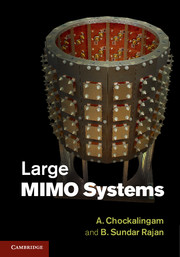Book contents
- Frontmatter
- Dedication
- Contents
- Preface
- Acknowledgments
- Abbreviations
- Notation
- 1 Introduction
- 2 Large MIMO systems
- 3 MIMO encoding
- 4 MIMO detection
- 5 Detection based on local search
- 6 Detection based on probabilistic data association (PDA)
- 7 Detection/decoding based on message passing on graphical models
- 8 Detection based on MCMC techniques
- 9 Channel estimation in large MIMO systems
- 10 Precoding in large MIMO systems
- 11 MIMO channel models
- 12 Large MIMO testbeds
- Author index
- Subject index
Preface
Published online by Cambridge University Press: 18 December 2013
- Frontmatter
- Dedication
- Contents
- Preface
- Acknowledgments
- Abbreviations
- Notation
- 1 Introduction
- 2 Large MIMO systems
- 3 MIMO encoding
- 4 MIMO detection
- 5 Detection based on local search
- 6 Detection based on probabilistic data association (PDA)
- 7 Detection/decoding based on message passing on graphical models
- 8 Detection based on MCMC techniques
- 9 Channel estimation in large MIMO systems
- 10 Precoding in large MIMO systems
- 11 MIMO channel models
- 12 Large MIMO testbeds
- Author index
- Subject index
Summary
The physical layer capabilities in wireless transmissions are growing. In particular, the growth trajectory of the achieved data transmission rates on wireless channels has followed Moore's law in the past decade and a half. Over a span of 15 years starting mid-1990s, the achieved wireless data transmission rates in several operational scenarios have increased over 1000 times. The data transmission rate in WiFi which was a mere 1 Mbps in 1996 (IEEE 802.11b) had reached 1 Gbps by 2011 (IEEE 802.11ac). During the same span of time, the data rate in cellular communication increased from about 10 kbps in 2G to more than 10 Mbps in 4G (LTE). One of the promising technologies behind such a sustained rate increase is multiantenna technology – more popularly referred to as the multiple-input multiple-output (MIMO) technology, whose beginnings date back to the late 1990s.
The interest shown in the study and implementation of MIMO systems stems from the promise of achieving high data rates as a result of exploiting independent spatial dimensions, without compromising on the bandwidth. Theory has predicted that the greater the number of antennas, the greater the rate increase without increasing bandwidth (in rich scattering environments). This is particularly attractive given that the wireless spectrum is a limited and expensive resource.
More than a decade of sustained research, implementation, and deployment efforts has given MIMO technology the much needed maturity to become commercially viable.
Information
- Type
- Chapter
- Information
- Large MIMO Systems , pp. xiii - xivPublisher: Cambridge University PressPrint publication year: 2014
